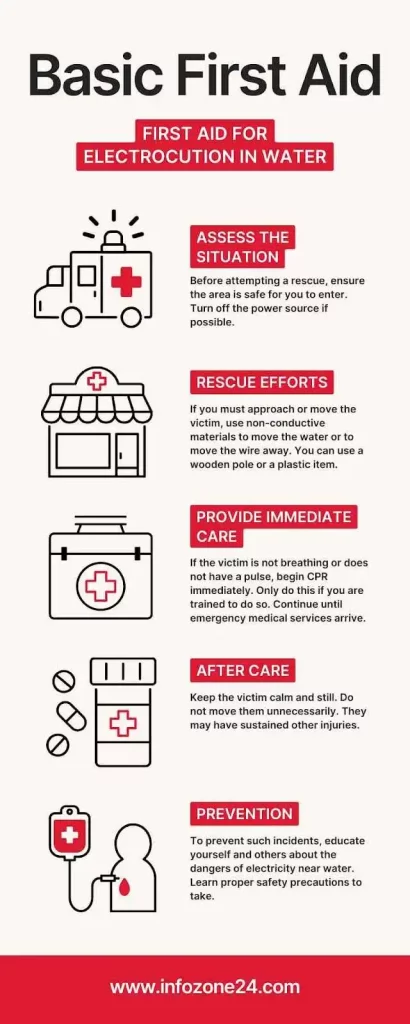The chemistry between electricity and water often challenges common expectations. It all has to do with the properties of water. We know that water is a conductor of electricity. Contrary to common belief, it is not water itself that is a good conductor of electricity. The impurities and ions in water ease electrical conduction. When we ask, “How far does electricity travel in water?” it’s important to consider this difference.”
The conduction of electricity through water is a complex phenomenon. The presence of dissolved minerals and salts influences it. These minerals and salts become charged particles and carry an electric current.
This article will answer the question, “How far does electricity travel in water?” We’ll also explain the factors influencing the conductivity of water. Moreover, we’ll share some ways to test electrified water.
Can Electric Current Travel in Water?
Yes, electricity can travel through water. Water is a good conductor of electricity. This is because of the impurities and ions in water. When there is electricity in water, electrons move through the water molecules. But, the amount of electricity that can travel through water is limited by its resistance. Remember that regular water conducts electricity faster than pure water.
Factors Influencing The Conductivity Of Water
How far can electricity travel through water? The electrical conductivity of water is not a straightforward matter. The distance that electricity would travel in water depends on many factors:
Type of water: Saltwater vs. Freshwater
Saltwater:
The electrical conductivity of Saltwater is higher. This is due to the presence of dissolved salts and minerals. These contribute to its ability to conduct electricity.
Any water other than distilled water contains salts and metals. Distilled water is deionized water. It is not present but is created in laboratories.
Freshwater:
But, freshwater’s conductivity is limited. This is because of its fewer impurities. These impurities affect how far electricity can travel in water. But, pure water is a good insulator.
Temperature and its Impact on Water’s Conductivity
The temperature of the water could affect its conductivity. There is a direct relationship between temperature and conductivity. As the temperature rises, so does the conductivity. The warmer the water, the faster its molecules move around. This results in increased electrical flow.
Why does this happen? The increased molecular movement at higher temperatures facilitates electrical conduction.
Voltage and Current
It is another factor affecting the flow of electricity in water. The initial strength of the electrical discharge plays a crucial role. Higher voltage and current can extend the reach of electricity in water.
This is why it’s not safe to swim in bodies of water during a lightning storm.
Electrical Resistance of water
The resistivity of water to electrical flow also determines how far electricity can travel. Freshwater has higher resistivity. It limits the travel of electricity more than salt water.
The Presence of Dissolved Gases: Aerated vs. Deaerated Water
Aerated water:
Aerated water is often found in swimming pools and hot tubs. It exhibits reduced conductivity due to the insulating effect of gas bubbles.
Deaerated water:
Deaerated water shows an enhanced conductivity. The absence of gas interference allows for a clearer path for electricity to flow.
Distance from the point of contact
When water contains electric current, how fast it travels to reach the human body depends on proximity.
So, the closer you are to an electrified water body, the faster the electricity will travel when you make contact. And the further you are, the lower the current would be.
The safe distance can be measured mathematically. The ratio of the fault current to the body current is used for this purpose. Here are four zones around the point source of electricity in water:
- High danger zone
- Danger zone
- Moderate risk zone
- Safe zone
These are the factors that affect the distance that electricity can travel in water. If water is highly electrified, you might see sparks and bolts in it.
Can Electricity Run Through The Sea Water?
Can Electric Current Flow Through Water? Yes, electricity can run through the ocean. The water molecules don’t conduct electricity. But, the salt and metals in the water do carry the electrons. The conductivity of seawater is high due to its high salt content.
Water is an excellent solvent for various minerals, chemicals, and other substances. However, the electricity quickly disperses with distance, reducing its strength.
Seawater is a highly conductive medium because of one reason:
The abundance of ions in seawater increases the conductivity of seawater. Seawater’s resistivity varies with salinity. And it impacts the distance electricity goes in the water. Water might have a higher mineral content or is contaminated. It’ll have higher conductivity and allow electricity to travel further.
How Far Can Electricity Travel When It Hits the Ocean
What Happens When Electricity Hits Water? When a lightning bolt hits the ocean, the electricity travels long distances. However, the distance it travels is highly variable. It depends on several factors:
- The strength of the electrical source
- Salinity
- Temperature
- The presence of other substances in the water
Roughly, lightning strikes in water typically travel 20 feet in water.
The salt content of seawater makes it a million times better at conducting electricity than pure water. However, it allows electricity to disperse rapidly, diminishing its strength.
The initial voltage of the electrical discharge also plays a significant role. A powerful lightning strike in water could carry current further.
But typically, electricity disperses quickly. The risk of danger to a localized area around the entry point is reduced this way.
How Far Does Electricity Travel in Freshwater
How far electric current can travel through fresh water? How Far Does Lightning Travel in FreshWater? Electricity does not flow through distilled water like it does through natural water. Lightning in freshwater spreads out differently than in salt water. This is due to lower ionic content.
The electrical current from a lightning strike disperses in freshwater. This limits its lethal reach to within a few meters from the strike point. The exact distance can vary. But, it’s generally not far. This is because of the reduced conductivity of fresh water compared to salt water.
However, it’s still dangerous to be in or near fresh water during a lightning storm. This can result in potential electrical shock.
Can Electricity in Water Kill You?
What happens if a live wire touches water? Water is an excellent conductor of electricity. Electricity in water can indeed be lethal. The danger arises from the electrical conductivity of water. Ions and dissolved minerals enhance this conductivity.
When the electricity goes into the water, it moves through the path made by impurities. The risks of electrical shock in water are particularly high. This is because water can spread electrical currents. For instance, if you drop a plugged-in toaster into a bathtub full of water, it can be deadly.
Electrical safety in water is a critical concern. For instance, in controlled environments like swimming pools and hot tubs. Here, electrical risks can lead to severe injuries or loss of life.
- If the current passes through your body, you could get electrocuted in water.
- If you’re in a pool during a lightning storm, the electricity can shock you through the water.
The conductivity of water varies with its content. Saltwater has a higher ionic content. It has greater conductivity compared to fresh water. So, electricity can travel farther and be more dangerous.
The resistivity of water is the measure of its opposition to electrical flow. It affects how far electricity can travel in water. Understanding these properties is necessary for ensuring electrical safety in water.
Water can conduct electricity in some situations, so it’s important to be cautious. The combination of water and electricity is very dangerous.
How to Test Electrified Water
How do you know if there is electricity in the water? You can use a device known as a voltage tester or a multimeter set to measure voltage. Here’s how you can test the presence of electricity in water:
Using a Non-Contact Voltage Tester
- Make sure that you’re wearing rubber-soled shoes and gloves for insulation.
- Hold the voltage tester near the water’s surface without touching it.
- Once this device comes in contact with water, it gives off either a red or a green flash and/or sounds an alarm.
Using a Multimeter
- Set the multimeter to measure AC voltage for household currents.
- Set it to DC if testing water around boats or cars.
- Insert the multimeter probes into the water.
- Keep your hands away from the water.
- A reading above 0 volts indicates the presence of an electrical current.
Professional Assessment:
You might need a thorough evaluation, especially in cases of suspected high voltage. You should contact a professional electrician or your local utility company. They will conduct a full assessment and ensure electrical safety in water.
Shock Alert is one of the best ways to test electrified water. It will notify you of electricity present in water. Watch the video titled, “How Can You Tell if Water is Electrified?”
First Aid for Electrocution in Water

Assess the Situation
Before attempting a rescue, ensure the area is safe for you to enter. If there is a source of electricity in contact with the water, do not enter the water. Turn off the power source if possible.
Immediately call emergency services. Provide them with detailed information about the situation and the location.
Rescue Efforts
If you must approach or move the victim, use non-conductive materials to move the water or to move the wire away. You can use a wooden pole or a plastic item.
If the victim is still in contact with the electrified water, do not touch them with your hands.
Provide Immediate Care
Once the victim is away from the source of electricity and it is safe to touch them, check if they are conscious. If they are unresponsive, call out loudly and tap on their shoulder.
If the victim is not breathing or does not have a pulse, begin CPR immediately. Only do this if you are trained to do so. Continue until emergency medical services arrive.
If the victim is responsive but in shock, lay them down with their legs elevated. Cover them with a blanket. And do not give them anything to eat or drink.
After Care
Keep the victim calm and still. Do not move them unnecessarily. They may have sustained other injuries.
If possible, monitor the victim’s breathing and pulse regularly.
Give a full report to the emergency responders when they arrive. Such as:
- How long the victim was in the electrified water, and
- Any first aid measures you administered.
Prevention
To prevent such incidents, educate yourself and others about the dangers of electricity near water. Learn proper safety precautions to take.
Ensure regular checks and maintenance of electrical equipment near water sources.
In an emergency involving electricity and water, ensure your safety and that of others around you. Only then can you effectively assist the victim.
Conclusion
So, how far electricity travels in water? We have explored the key factors influencing the speed of electricity in water. Also, how they affect how far electricity can travel in water. Roughly, lightning strikes in water can travel through the water up to 20 feet.
Electricity travels faster in rainwater or tap water and at high temperatures. Recognizing the importance of safety around water and electricity is essential. It is necessary to ensure electrical safety in water.
It is our collective responsibility to engage in responsible and sustainable practices. We need to cut the environmental impacts. We should also ensure the delicate balance of our ecosystems.
Read Now: Cost of Buying Food in Canada By Province
Michael C Vang is a passionate blogger. He has been blogging since 2013 on a variety of topics. He is committed to creating informative and engaging content that helps readers learn more about everything.



